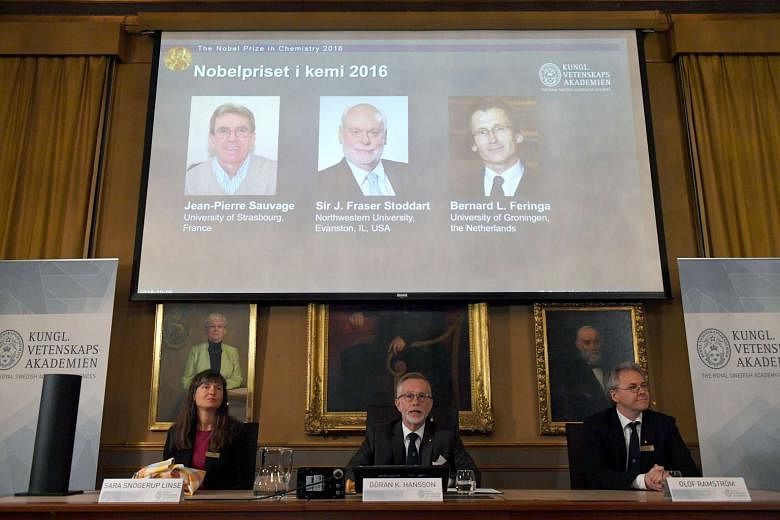STOCKHOLM (AFP) - A French, British and Dutch trio of scientists won the Nobel Chemistry Prize on Wednesday (Oct 06) for developing the world's smallest machines that may one day act as artificial muscles to power tiny robots or even prosthetic limbs.
Jean-Pierre Sauvage of France, Fraser Stoddart of Britain and Bernard Feringa of the Netherlands "have developed molecules with controllable movements, which can perform a task when energy is added," the jury said.
Inspired by proteins that naturally act as biological machines within cells, these synthetic copies are usually made up of a few molecules fused together.
Also called nanomachines or nanobots, they can be put to work as tiny motors, ratchets, pistons or wheels to produce mechanical motion in response to stimuli such as light or temperature change.
Molecular machines can move objects many times their size.
"The molecular motor is at the same stage as the electric motor was in the 1830s, when scientists displayed various spinning cranks and wheels, unaware that they would lead to electric trains, washing machines, fans and food processors," the Nobel jury said.
Molecular machines will "most likely be used in the development of things such as new materials, sensors and energy storage systems," it added.
The three laureates will share the eight million Swedish kronor (S$1.2 million) prize equally.
Feringa, a 65-year-old professor at the University of Groningen, told reporters at the Nobel press conference the prizewinning research offered great opportunities for the future.
"I feel a little bit like the Wright brothers, who were flying 100 years ago for the first time. And then people were saying, 'why do we need flying machines?' And now we've got the Boeing 747 and the Airbus," he said by video link.
"We will build those smart materials in the future. That is a big opportunity - materials that will reconfigurate, that will change, that will adapt themselves, that have properties that can change because they pick up a signal."
The first step towards a molecular machine was taken by Sauvage in 1983, when he succeeded in linking together two ring-shaped molecules to form a chain.
Normally, molecules are joined by strong bonds in which the atoms share electrons, but in the chain they were instead linked by a freer mechanical bond.
"For a machine to be able to perform a task it must consist of parts that can move relative to each other. The two interlocked rings fulfilled exactly this requirement," the Nobel jury said.
Sauvage, 71, told AFP he was "very surprised" and "felt enormously happy" to win the prize.
He is the director of research emeritus at France's National Centre for Scientific Research (CNRS).
The second step was taken by Stoddart in 1991, when he threaded a molecular ring onto a thin molecular axle and demonstrated that the ring was able to move along the axle.
"Among his developments... are a molecular lift, a molecular muscle and a molecule-based computer chip," the jury said.
Stoddart, 74, is a professor of chemistry at Northwestern University in the US.
Growing up on a farm in Scotland without electricity or any modern-day conveniences, he occupied himself doing jigsaw puzzles, a pastime that helped him recognise shapes and see how they can be linked together.
His fascination with shapes continued in his research: the ring-shaped molecule mechanically attached to an axle that he developed is called a "rotaxane".
Honoured by Britain's Queen Elizabeth II with the title of knight bachelor in 2006, Stoddart told AFP of his Nobel prize: "I'm surprised, I'm thrilled, I'm overjoyed".
He said he, Sauvage and Feringa were "the very closest of friends... We're almost what I would call scientific brothers."
Stoddart, whose wife died of breast cancer in the late 1990s, said their technology could be used to treat cancer in the future.
"You can control a drug and not have it come all at once, so it can last much longer and be used much more efficiently with a smaller dose than the often hard-core cancer treatments, for example."
Feringa was, meanwhile, the first person to develop a molecular motor - in 1999 he was able to make a molecular rotor blade to spin continually in the same direction. Using molecular motors, he has also designed a nanocar.
Like Stoddart, Feringa was raised on a farm and was attracted to chemistry by its endless opportunities for creativity.
When he produced the first molecular motor in 1999, he succeeded in getting it to spin in one direction.
Normally, molecules' movements are governed by chance; on average, a spinning molecule moves as many times to the right as to the left.
But Feringa was able to design a molecule that was mechanically constructed to spin in a particular direction.
The work of the three laureates has created a molecular toolbox to build increasingly advanced creations, the jury said.

